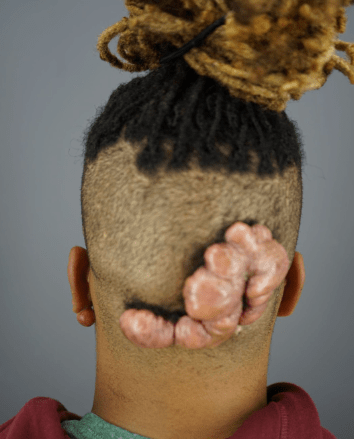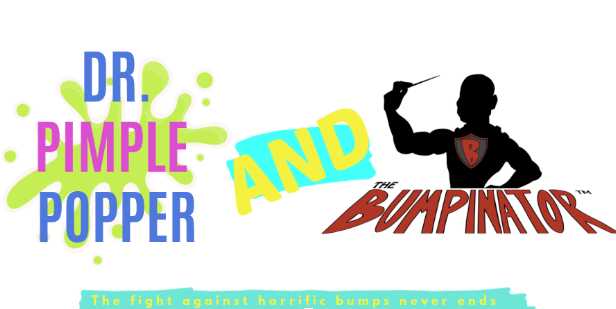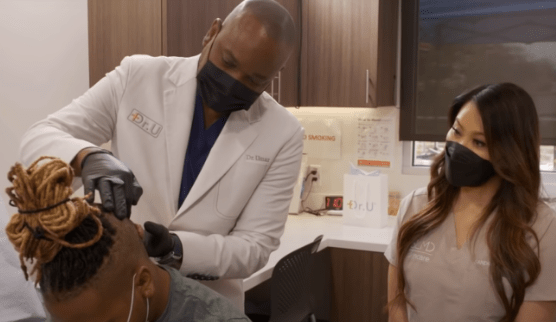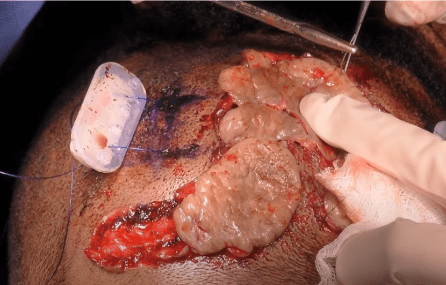When a 28-year-old patient named Robert turned to Dr. Sandra Lee, AKA Dr.Pimple Popper, to remove the keloid scars on the back head and another on the left earlobe, Dr.Pimple Popper was shocked at the size and shape of the keloidal mass on his head. She quickly realized she’d need to enlist Dr. Umar, AKA Dr.Bumpinator, for help.
Dealing with It Since 9 Years-Old
Robert’s keloid scar on the back of his head had started forming when he got his ears pierced at 18. The one on the back of his head dated even older. When he was 9-10 years old, Robert had an accident and injured his head with a glass table. After he got medical help for it and the sutures were removed, that’s when the keloid started forming. Initially, it was only the size of a penny, and Robert figured he could get it surgically removed.
However, it turned out to be more complicated than that. Robert had to get five surgeries because every time doctors would attempt to remove the keloid scars, they would come back even more aggressively and invade more of his scalp. With each time, he was losing more hope of ever being free from the keloid lesions.

Robert didn’t like how he would get stares and judgemental looks because of his keloids. He covered it daily by putting his braids in a ponytail and then spreading the ponytail over the bigger keloidal growth to ensure it wouldn’t be so apparent from the back. But trying to hide the keloids from the world every single day felt tiring and humiliating.
A Job for Two

While the keloid on Robert’s ear was something Dr. Lee wouldn’t have a problem removing, she judged that the one on his back was outside the scope of her practice routine.
It was essential to remove the mass, but an equally important objective was to ensure the keloid wouldn’t return again.
Dr. Lee knew just who to reach out to for the job.
Resourceful Dr. Pimple Popper Calls Dr. Bumpinator
Dr. Sanusi Umar (aka Dr.Bumpinator) is a world-renowned dermatologist and head of scalp and hair disorders at Harbor – UCLA medical center and owner of the Dr. U Hair and Skin Clinic in Manhattan Beach California has developed several innovative surgical techniques to help sufferers of AKN and keloid bumps fight the battle effectively.
When Dr. Sandra Lee sent Dr. Umar photos of Robert’s keloids, Dr. Umar felt he’d be able to help the young man finally be free of the serpentine keloidal mass.

However, when the day of the procedure arrived and both Dr. Lee and Robert – along with his girlfriend, arrived, Robert’s case proved to be particularly challenging.
“Looking at Robert’s keloid for the first time, I felt totally stumped. Robert doesn’t have any laxity on his scalp, so what will it take to make sure the keloid doesn’t come back this time” wondered Dr. Bumpinator.
Another worry about the case was how well the scar would heal and whether the scar healing itself would trigger another keloid regrowth or not. Dr. Pimple Popper explains how the wider the base of the keloid, the harder it is to cover up the wound in a way so that the scar heals in an esthetically acceptable way, but there isn’t too much tension to aggravate the area and prompt the keloid to grow back.
Is Sixth Time the Charm?
During the procedure, Robert was to stay awake. Dr. Umar and Dr. Sandra Lee thought there was no need to put him under general anesthesia. It would be best to keep the patient awake – he’d be aware of the procedure and could communicate any questions or concerns he might have.
Dr. Umar’s strategy for the case was to use a multitude of techniques. This was to ensure the keloid didn’t stand a chance. In other words, he strategically planned out an attack on all fronts. Dr. Umar decided to employ four advanced and unique techniques after discussing those with Robert and getting his consent.
The first technique employed for the procedure was using the Athena suture guards, invented by Dr. Bumpinator. Those guards diffuse tension so that the sutures themselves don’t put too much stress on the operation site or cut the tissue by pulling too much. If the pressure from the sutures pulling the scalp is too high, that may trigger the keloid to regrow, which Dr. Umar and Dr. Sandra Lee were trying to prevent.
Next, Dr. Umar will extract fat from Robert’s abdomen and process it into micronized form called nanofat. The nano fat would be injected into the keloid-removal wound to promote optimal healing. The stem cells in the nano fat would influence the healing process favorably. “Those stem cells influence how the area behaves for the next few weeks and promote optimal wound healing,” said Dr. Umar.
This Could’ve Potentially Been a Problem
The third innovative technique for minimizing the chance of keloid recurring proposed by Dr. Bumpinator involves the application of an extracellular matrix. This matrix is derived from the porcine (Pig) bladder. This has the potential to minimize scar formation. However, with Dr. Pimple Popper, he decided first to consult Robert about how he feels about using pig products in his body. The two doctors are mindful of the possible religious/ethical conflicts some may have about using pig products such as the extracellular matrix called Acell. The use of porcine products may be of concern to strict observers of kosher or halal restrictions. Fortunately, Robert confirmed that he was okay with using the extracellular matrix.
Finally, the 4th technique was to have Robert undergo radiation treatment to be administered locally to the wound created by the keloid removal. Dr. Umar and Dr. Sandra Lee decided that to add another layer of assurance that the keloid wouldn’t grow back, it would be best for Robert to undergo three rounds of radiation. Keloids are essentially non-cancerous tumors, and tumors – benign or malignant, tend to respond to X-rays. Although X-rays are not always 100% effective in keloid treatment, they significantly decrease the chance of the keloid returning. By administering radiation treatment on Robert’s post-operation site, in addition to all the other measures taken, Dr. Sanusi Umar (aka Dr. Bumpinator) felt more confident that the keloidal mass would be gone for good.
Patchwork with the Keloidal Skin
After removing the keloid scar, the next task on the table was closing the wound. Since the base of Robert’s keloid was quite large, bringing the edges together for primary healing wasn’t an option. Dr. Umar decided to use the top layer of skin on the keloidal mass to cover up the wound. The challenge was that the skin taken from the mass was not flat or wide. That made cutting out the shape needed to cover up the site impossible. This was nothing to stop Dr. Bumpinator, though! He figured out a way to cut out smaller pieces of the skin to use them for his unique patchwork.
Once done stitching up the skin pieces to cover up the wound, Dr. Umar put dressings all over the wound to hold the skin in place.

Doing the Impossible
After undergoing five failed surgeries, including a previous post-operative radiation treatment for his keloids, Robert was starting to think he would never be permanently free from the lesions. The keloids affected his self-esteem and brought down his overall quality of life. It even took a toll on his relationship with his girlfriend. Because of his intense headaches, Robert sometimes had a cross-attitude. Despite his girlfriend Nailah being a patient and understanding woman, it was putting unnecessary strain on their personal lives.
“I thought my keloids would be with me forever,” says Robert.
He explains how he had constant headaches and itching and didn’t feel good about himself.
“Dr. Umar’s (Dr. Bumpinator) special treatments did the trick! He’s a skin wizard in my eyes”.
Watch the Dr. Pimple Popper episodes covering Robert’s case below.
Frequently Asked Questions
What’s inside a keloid?
Keloids are formed when the skin is trying to heal itself and overproduces collagen. The site of the wound ends up with a raised scar. That scar can keep growing if the skin continues producing collagen. To answer your question, a keloid is a raised scar, so although it may ooze pus or bleed, it doesn’t have much junk inside like pimples or cysts do.
Do keloids go away naturally?
Keloids tend to grow and get bigger over time. Most of the time, even when a keloid stops growing, it doesn’t stay resolved. In rare cases, more minor keloidal bumps may flatten by themselves, but they won’t go away completely. If your keloid is bothering you, you should see an expert who can remove the keloid scar for you.
I have a tiny keloid. Would it be okay if I sanitize a scalpel and remove it myself?
The keloid formed because your injured skin failed to heal itself properly. It overcompensated for the injury by producing too much collagen, which then became the keloid. This means you are prone to developing keloidal bumps. Unless you’re a dermatologist, you most likely don’t know how your skin will react to you cutting off the keloid. The incision you’d have to make will essentially be registered as another injury to the skin. Unsurprisingly, this will likely trigger a bigger keloidal growth. Don’t try to remove the keloid scar yourself; seek a medical professional’s help instead.